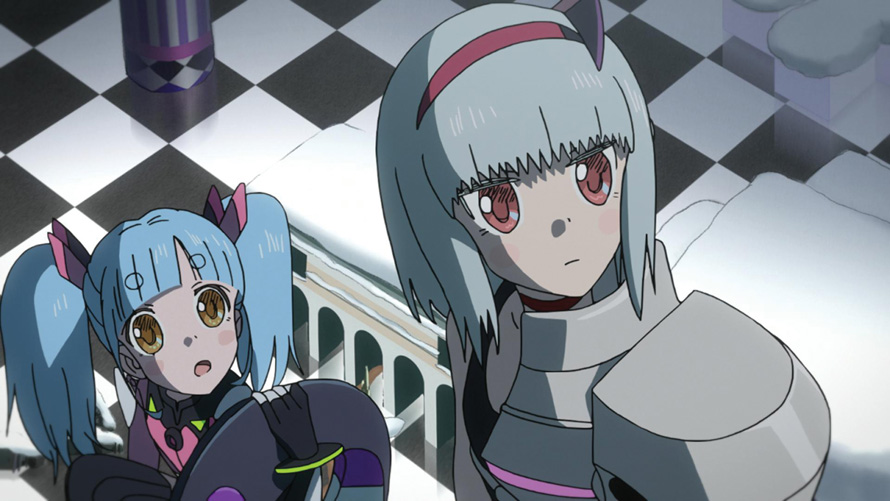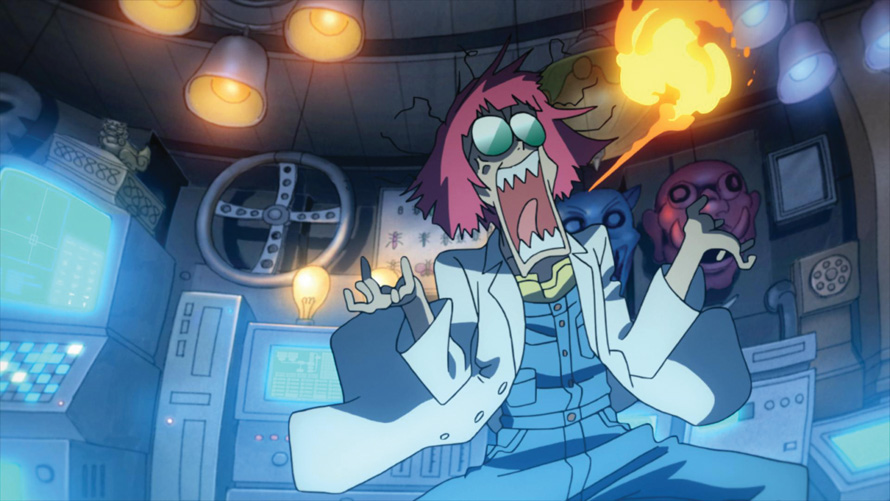Mind Over Matter

If there’s one thing I’ve learned from watching anime, it’s that, sometimes, the best anime don’t need any source material. The anime industry doesn’t really have the wiggle room for original works, which makes anime-first works such treats to watch. Take, for example, the likes of Puella Magi Madoka Magica, Kill la Kill, and Girls und Panzer. They were successful shows because wiggle room was provided for them to be different, rather than just sticking to mere preexisting scripts (a decent budget certainly helped as well).
And then there’s Flip Flappers, which is really something else. It’s an original anime production from Studio 3Hz, with direction by Kiyotaka Oshiyama, who is primarily known as a skilled key animator who has contributed his skills to plenty of well-known projects. This might raise a few eyebrows, but Oshiyama doesn’t just knock the ball out of the park with this unique anime. Instead, the bat turns the ball into a jellyfish, which then explodes into a barrage of rainbow-colored fish that sing Beethoven when they fall from the stratosphere. Yes, that sounds completely ridiculous, but Flip Flappers has proven that “completely ridiculous” is what it excels at.

When you watch the first episode, you might believe this story is going to play out like a regular magical girl story. Cocona, a seemingly gloomy middle school student full of uncertainty about her future, is going to have her life turned upside down and inside out when the free-spirited Papika, a mass of energy and life compressed into human form, drags her into Pure Illusions, strange, dreamy worlds that wouldn’t appear out of place in a few fairy tales. One girl shows the other the importance of friendship and, ultimately, the two forge an unbreakable bond as unstoppable magical girls that can tear through any bad guy who comes at them with the power of hope, dreams, and friendship.
Well, that’s how shows like this are supposed to play out, right? But one trip to Pure Illusions is all it takes for Cocona to say “no thanks” when asked if she wants to go on another adventure. I was NOT expecting that. I was, however, expecting her to get dragged into another adventure. And then another. And then another. After all, what are you going to fill the other 12 episodes with if the main character just says no in the first episode? The point is, as you might have guessed, Flip Flappers isn’t your average magical girl anime.

Early on, in fact, Flip Flappers seems to have an ironclad commitment to not explaining anything that’s going on. Two episodes tend to differ from each other more than they resemble each other, which might not appeal at first. Of course, that ends up not mattering because it ultimately becomes a visually enchanting delight. All the worlds Cocona and Papika explore are charged with whimsy and weirdness, and they run the gamut in terms of intense colors and narrative insanity, as the girls find themselves visiting a brightly colored knockoff of Alice’s Wonderland, an endless desert where they duel with Mad Maxian thugs, a darkly lit school straight out of a horror film where they sip tea with voiceless schoolgirls, and an abstract, futuristic, mecha-filled metropolis that glows like a museum full of neon signs. Oh, and there’s a Sailor Moon-esque transformation sequence in the Mad Maxian world. Not even Salvador Dali could think up that one! It’s honestly like the animators wanted to throw in as many different anime concepts as they possibly could before the clock ran out, and the final product ends up being what might be considered a love letter montage to anime itself.
But all of these worlds also point to the show’s ambitious juggling act of ideas. On one hand, Flip Flappers establishes a running theme of psychology. Though the show establishes a focus on Cocona and Papika and their journey to gather shimmering stones called “amorphous fragments,” this struggle slowly reveals the show’s greater scheme. The Pure Illusion worlds aren’t just simple fantasies. Turns out they are the fantasies of people they already know. The world in which the girls suddenly act more rabbit-like? It’s the mind of Cocona’s pet rabbit. The Mad Max world? A fantasy imagined by one of the girls’ allies.

And with these personal portraits, Flip Flappers hones in on a story about a girl and a little thing called puberty. Take the seventh episode, where Cocona finds herself in a Pure Illusion populated by variations of Papika, with the “real one” nowhere in sight. Turns out, this world is an echo of Cocona’s current state of mind: She’s obsessed with Papika. I’m not going to get into the specific details, but speculation that this show is actually a love story between two girls is answered with a resounding “YES.” The Japanese have a term for this—it’s yuri, a whole genre involving love between women. There are a lot of different ways you can address something like that. Fortunately, from what I saw, Flip Flappers addresses the topic reasonably well. It never tries to make a joke about it, and no one else tries to dissuade the possibility. It simply allows Cocona to figure herself out. Having that depicted so honestly in this show is not only refreshing, it almost seems groundbreaking.
So in the end, what does Flip Flappers end up being? Is it a gallery of the anime that came before it? Is it a commentary on the way we examine our own fascinations? Or is it just a love story that never lets you know what’s going to happen next? Ultimately, after watching it all, I find that underneath all of the abstractions and oddball visuals, Flip Flappers is built around the age-old questions: Who am I? Where am I going? What do I want? This is an earnest show that encourages compassion while its protagonists rebel against what we normally expect, and it’s all an adventure I’d be happy to go on again.
Flip Flappers is available from Sentai Filmworks and HIDIVE.
This story appears in the February 2018 issue of Otaku USA Magazine. Click here to get a print copy.




![SSSS.Dynazenon [Anime Review] SSSS.Dynazenon [Anime Review]](https://otakuusamagazine.com/wp-content/uploads/2021/08/16-9-SSSS.Dynazenon_Key_Visual_3.5-480x360.jpg)
![Back Arrow [Anime Review] Back Arrow [Anime Review]](https://otakuusamagazine.com/wp-content/uploads/2021/07/ba15-02686-480x360.jpg)
![Dawn of the Witch [Manga Review] Dawn of the Witch [Manga Review]](https://otakuusamagazine.com/wp-content/uploads/2021/07/16-9-DawnoftheWitch-cvr_02-480x360.jpg)
![Nina The Starry Bride [Manga Review] Nina The Starry Bride [Manga Review]](https://otakuusamagazine.com/wp-content/uploads/2021/07/nina-the-starry-bride-v1-16-9-480x360.jpg)